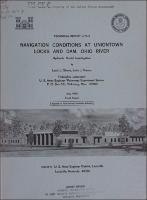Please use this identifier to cite or link to this item:
https://hdl.handle.net/11681/13588| Title: | Navigation conditions at Uniontown Locks and Dam, Ohio River : hydraulic model investigation |
| Authors: | United States. Army. Corps of Engineers. Louisville District Shows, Louis J. Franco, John J. |
| Keywords: | Hydraulic models Locks Waterways Inland navigation Navigation conditions Uniontown Locks and Dam Ohio River Hydraulic structures |
| Publisher: | Hydraulics Laboratory (U.S.) Engineer Research and Development Center (U.S.) |
| Series/Report no.: | Technical report (U.S. Army Engineer Waterways Experiment Station) ; H-75-9. |
| Description: | Technical Report Abstract: As part of the program for the modernization of navigation facilities on the Ohio River, Uniontown Locks and Dam will replace some of the existing lowlift locks and dams and provide a navigable pool about 69.7 miles long to the Newburgh Locks and Dam. The structures will include two parallel locks along the right bank and a dam consisting of a gated spillway and fixed overflow section. A fixed-bed model, reproducing about 8.6 miles of the Ohio River channel, Wabash Island with the back channel around the island, and about one mile of the lower reach of the Wabash River and the adjacent overbank areas, was constructed to an undistorted scale of 1:120. The model investigation was concerned with the study of the composition and configuration of the dam, arrangement of the locks and lock walls, and navigation conditions in the lock approaches. Results of the investigation revealed the following: (A.) Satisfactory navigation conditions could be developed with either the 10-gate or 12-gate spillway located in the main channel. With the gate sill of the 10-gate dam lowered 5 ft below that of the 12-gate dam, the water-surface elevation upstream showed little difference. (B.) Flow in the back channel, left of Wabash Islan, would tend to be considerably less than with existing conditions during flows that do not substantially overtop the fixed section across the channel when the gated spillway is entirely within the main channel. (C.) Flow through the back channel during low river discharge with the gated spillway in the main channel can be increased by excavation of the head of Wabash Island and the entrance to the back channel and with a training dike directing flow into the channel. (D.) Currents in the upper approach to the locks wou.ld be affected by the eddy forming in the scallop in the right bank. However, placing a fill along the bankline and extending across the scallop reduced the effect of the eddy on navigation. (E.) Ports would be required in the upper guard wall of the riverward lock to lessen the intensity of the crosscurrents near the end of the wall. (F.) Satisfactory navigation conditions could be provided with a third lock located either riverward or landward of the two adjacent locks. Replacing upper guide walls (land-side) with guard walls improved navigation conditions for downbound tows and reduced interference between tows using alternate locks. (G.) During construction of the spillway, navigation conditions could be difficult and possibly hazardous with the first-stage cofferdam under certain flow conditions. NOTE: This file is large. Allow your browser several minutes to download the file. |
| Rights: | Approved for public release; distribution is unlimited. |
| URI: | http://hdl.handle.net/11681/13588 |
| Appears in Collections: | Technical Report |
Files in This Item:
| File | Description | Size | Format | |
|---|---|---|---|---|
| TR-HL-75-9.pdf | 12.5 MB | Adobe PDF |  View/Open |